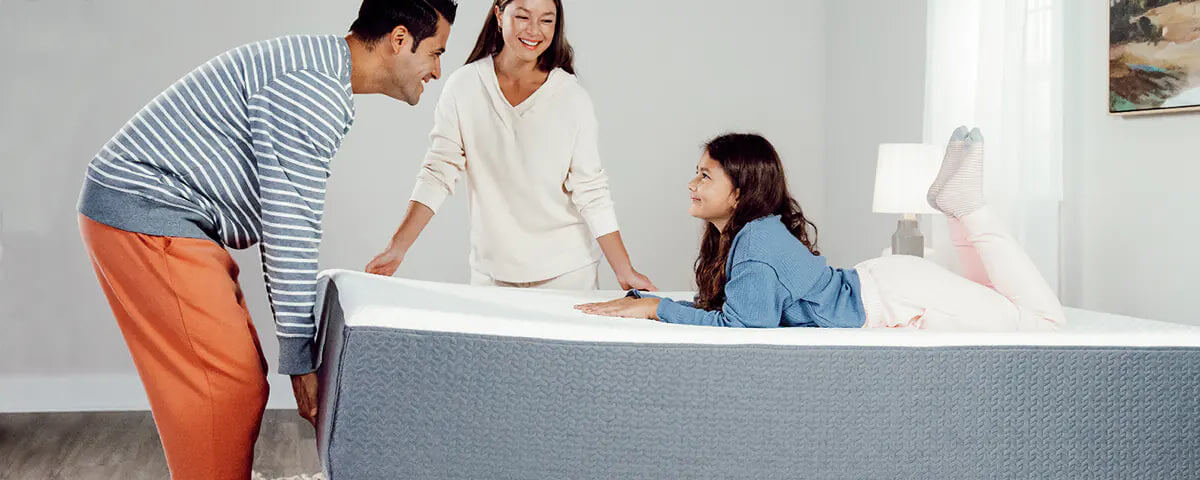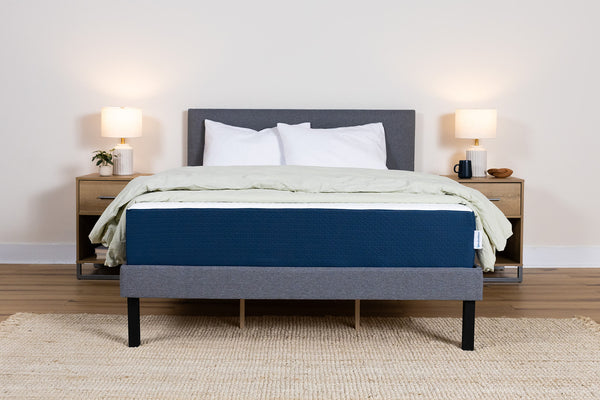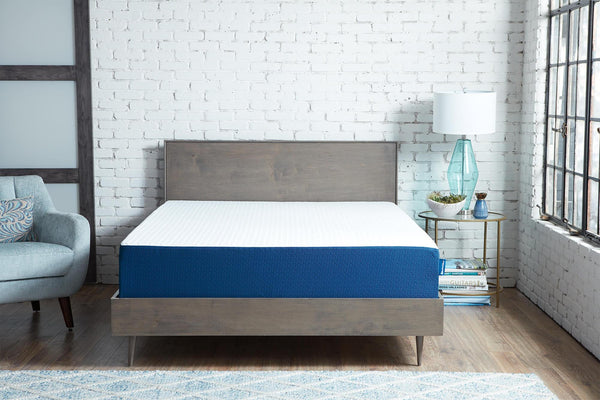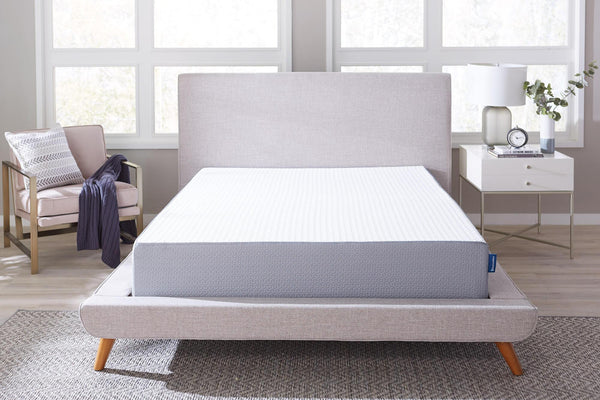Memory Foam vs. Latex Mattresses

Contents
What is a memory foam mattress?
Memory foam is a pliable foam that contours around the body to provide moldable support, or what we commonly refer to as a hugging sensation. Most memory foam mattresses are constructed with two or more layers of foam, the top layer always memory foam with the bottom most layer usually a dense support foam. The construction of your memory foam mattress determines how soft or firm it will feel.
The Science Behind Memory Foam
Memory foam is a type of polyurethane foam. Well, what is polyurethane? Polyurethane is made up of polymers, which are big molecules (synthetic or natural) that are bonded together with urethane to create a chain. The polyurethane is mixed with other substances to create memory foams of varying densities, all of which having unique conforming properties that allow it to contour to our bodies. Memory foam is ultimately designed to achieve an even and equal body weight distribution when we sit or sleep on the material. BedInABox® mattresses are built with a number of different BedInABox® memory foams to provide every level of firmness and support.
CertiPUR-US® Certification: Safety First with BedInABox
All memory foams used in BedInABox® mattresses are CertiPUR-US® certified. This means that the foams used to make our memory foam mattresses have been tested for content, emissions and durability by accredited labs. By making our memory foams and mattresses in house, we are able to control everything from manufacturing to delivery to guarantee the highest quality product in every box.
What is a latex mattress?
Latex mattresses fall under the category of foam mattresses; however, they are different from memory foam because they are made from an entirely different material. Latex foam can be derived from natural or synthetic materials.
Natural latex is made from the sap of the Brazilian Rubber Tree, making it an eco-friendly option free from harsh chemicals.
Synthetic latex is usually made from Styrene-Butadiene Rubber (SBR), which is a rubber substitute.
Different Ways to Make Latex
There are two different methods to make latex foam: the Dunlop process and the Talalay process. Both processes use vulcanization to harden the rubber with heat. Let’s explore these two methods some more.
The Dunlop Method:
This late nineteenth century process completely fills a mattress mold, which creates a mattress with a denser bottom and a slightly softer top due to settling of the materials.
The Talalay Method:
The Talalay process only partially fills a mold. The remainder of the mold is then filled with air via vacuum to expand the latex. This creates a latex with lower density, which results in a softer feel compared to latex foam poured via the Dunlop method.
The Feel of Latex Mattresses
Latex has more elasticity than memory foam which translates to more bounce. It does not contour like memory foam, either. Latex mattresses generally have a medium-firm feel and create compression around the body versus contour.
As previously mentioned, Dunlop and Talalay mattresses have different feels, as well. Dunlop latex is denser and generally feels firmer versus Talalay latex, which is less dense and thus, feels softer.
Comparing Comfort Levels
Temperature and Support
Memory foam is now known for its pressure-relieving qualities. The more you use it, the more it imprints on your body and sleeping patterns. Similar to clay, it becomes more malleable over time. Also like clay, it reacts to temperature fluctuations. When cold, the foam feels firmer; when warm, it becomes softer and has more elasticity. Its unique reaction to pressure and temperature is what makes memory foam stand out against other mattress constructions. More recently, many memory foams are designed with cooling technologies.
While the mattress industry grows every day, latex still has a small share of the market.
Latex mattresses are known for their elasticity and fast rebound time whenever pressure is applied, essentially the opposite of what memory foam mattresses are known for. This makes latex mattresses preferable for active sleepers. Since the latex foam isn’t cradling you, you can move more easily but there is less pressure relief than memory foam mattresses, as a result. Latex also tends to have less edge support than memory foam, which can leave you feeling like you’re rolling off the bed if you sleep close to the edge. However, latex is more breathable and inherently regulates temperature, which can keep you sleeping cooler at night.
Mattress Durability
Most sleep and mattress organizations generally suggest replacing your mattress every 5-10 years. Memory foam mattresses are generally more durable than innerspring mattresses though, lasting anywhere from 8 to 15 years. The durability of your mattress correlates to the density of the foam in your mattress. When you buy BedInABox®, you’re guaranteed longevity. Our mattresses are backed by a 20-year warranty because they are built with high quality, American-made foams that are built to last.
Latex mattresses are durable and typically last 10-15 years, which helps explain their higher price point. The frequency with which you use your mattress and how wll you maintain it will have an impact on it’s lifespan.
Understanding Motion Transfer
While a latex mattress tends to bounce more with movement, a memory foam mattress absorbs movement. The polyurethane memory foam material slowly releases applied energy by evenly distributing pressure. Because memory foam cells are impacted independently of each other, motion is not spread quickly to other parts of the mattress. If you share a bed with a restless sleeper, a memory foam mattress eliminates the quick spread of movement so you don’t feel it.
Latex mattresses are not as great at isolating motion. Because of their elasticity, there is more noticeable motion transfer when you or a partner moves. Natural latex is inherently stretchy, making it even more vulnerable to movement than synthetic latex.
Maintenance and Upkeep
Caring for your BedInABox® memory foam mattress is surprisingly easy. To simplify upkeep, we suggest topping your mattress with one of our BedInABox® mattress protectors. In using a mattress protector, you are creating a breathable, washable barrier against dust mites, bacteria, and fluids that helps protect the integrity of your mattress materials, which generally prolongs the life of the mattress itself.
For more thorough cleaning, try gently vacuuming with a clean nozzle and spraying any problem spots with a gentle cleanser. For detailed information on cleaning and disinfecting your mattress, please visit our Mattress Cleaning Guide.
Caring for a latex mattress is simple and very similar to memory foam maintenance. The cell structure of latex mattresses actually makes maintenance a little easier. They are inherently hypoallergenic, they are not prone to holding moisture, and they really don’t need to be rotated with frequency. However, whenever you do notice dirt or spills, we always suggest gently vacuuming the debris, blotting spills and allowing your latex mattress to air dry.
Health and Safety Standards
The most common allergen affecting bedtime is the dust mite. Dust mites are microscopic arthropods that thrive in warm, humid environments. They find crevices to live in and feed on dead skin cells. Because memory foam and latex are both naturally dense, they do a good job blocking dust mites and other microbes from invading your sleeping space, especially with regular cleaning. BedInABox® offers hypoallergenic sleep essentials including a weighted blanket and mattress protectors to maintain a clean sleep environment, as well. All BedInABox® mattresses also maintain the CertiPUR-US® nd OEKO-TEX® STANDARD 100 certifications, ensuring their safety.
One thing to consider before choosing a latex mattress is if you have a latex allergy. Latex allergies are actually caused by a rubber protein in the latex. Some companies claim that the rigorous washing process diminishes many of the protein allergens, however, there is not enough literature on studies between latex mattresses and the latex allergy, so we always recommend consulting with a doctor.
Cost Considerations
While memory foam mattresses tend to come with a higher price tag, at BedInABox® we provide quality mattresses at a more affordable price. We handle your mattress from manufacturing to delivery, allowing us quality control at every step of the process. Every mattress is delivered with a 120-night risk-free trial, too, so you can be sure that a BedInABox® mattress is right for you—no strings attached!
Out of the three main mattress types—innerspring, memory foam, and latex—latex is the most expensive material. Natural rubber latex is labor intensive to farm and the most time-consuming mattress-making process. Natural rubber latex mattresses are often touted as the most eco-friendly mattress, too. Another contributing factor to the cost is the limited availability of natural latex. If procured ethically, rubber trees must be tapped under certain conditions so as to not damage the tree or its environment. Natural latex mattresses may cost several thousand dollars.
Which mattress type is right for you?
Memory Foam Mattress Features:
- Cradling comfort
- Pressure relief for neck, spine and hips
- Motion Isolation
- Can be constructed with cooling technologies
- Great support for all sleep positions
- Hypoallergenic
Latex Mattress Features:
- Bouncy
- Medium-firm feel
- Medium motion transfer
- Temperature regulation
- Hypoallergenic
- Eco-friendly
- Durable
At the end of the day, you know what is best for you. Every person has their own sleep preferences, making one mattress better for them than another. Mattress shopping is your own unique experience but you don’t have to do it alone. Still have questions about the difference between memory foam and latex mattresses? Contact us today to begin your journey towards better sleep.
Frequently Asked Questions
Which mattress type conforms better to your body, memory foam or latex?
BedInABox® memory foam conforms to your body more perfectly than latex can. The adaptive structure of memory foam gives more cradling support to pressure points and every curve of your body, giving you the "hugging" feel that memory foam is known for. While latex is not as good as giving you a body-conforming experience, it is very responsive and bouncy. Sleepers who want support for their specific body shape will prefer the body-conforming sensation of memory foam rather than other materials.
Is memory foam better for pressure relief than latex?
Yes, BedInABox® memory foam is designed to relieve pressure on the hips, shoulders and back. It contours your shape and distributes weight evenly to minimize aches and to help improve sleeping posture. Latex will compress a bit but doesn't provide the depth of pressure relief or targeted luxury that memory foam offers, making it a better long term solution.
Which mattress is quieter: memory foam or latex?
BedInABox® memory foam mattresses are almost completely silent when you move around on them. Unlike latex, which has a natural rebound and can create sound when moved, our memory foam absorbs energy and stays quiet, making mattresses ideal for couples or light sleepers who do not want to feel any rustling or bouncing during the night.
Does memory foam isolate motion better than latex?
Definitely. BedInABox® memory foam has top-level motion isolation qualities. Its cell structure dampens motion at the point of origin and significantly restricts it from transitioning across the mattress. Latex is more elastic so it's usually going to conduct more motion across the surface. If you sleep with a partner, memory foam is ultimately a better option if you're worried about them tossing and turning in the night waking you up.
Which option is more suitable for side sleepers, memory foam or latex?
For side sleepers, memory foam from BedInABox® is often the preferred choice. Memory foam can relieve pressure on the shoulders and hips while keeping the spine aligned. A contoured support reduces pressure on joints that can cause discomfort. Specifically, latex may not give the same customized relief for some pressure points if side sleepers find it bounce and medium-firm.
Is memory foam typically more affordable than latex mattresses?
Yes, memory foam is typically cheaper to manufacture and sell, especially a memory foam mattress from BedInABox®, than latex. The high cost of manufacturing natural latex drives the price up. Every mattress sold under the BedInABox® brand is an American-made memory foam mattress that is premium quality, comfort, and longevity without the high price. Each mattress is backed by a 20-year warranty and a 120-night, risk-free sleep trial period to ensure the consumer's satisfaction.


